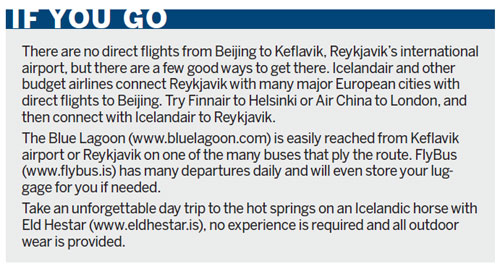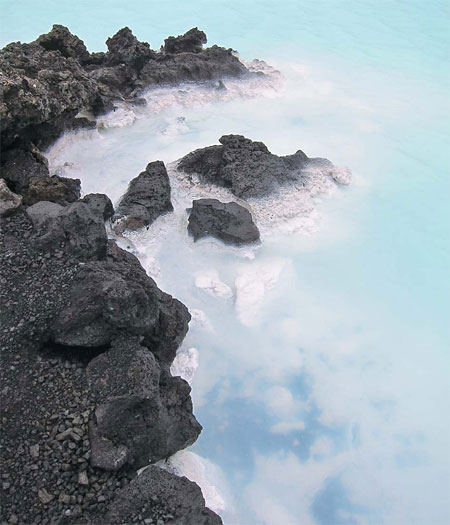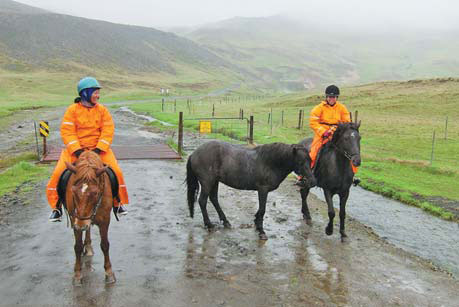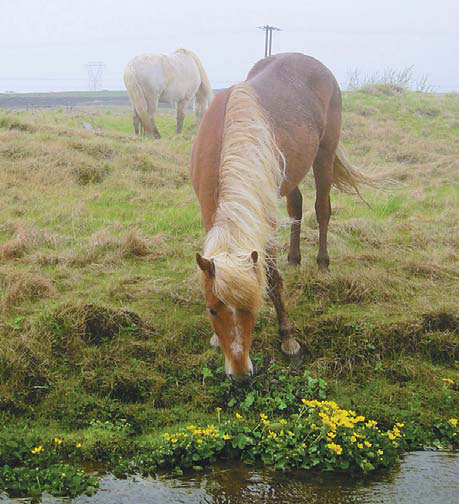From horses to hot spa
Updated: 2013-06-30 07:39
By Elisabeth Lee(China Daily)
|
|||||||
|
The white mud around the edges and bottom of the Blue Lagoon is great for your skin, and the therapeutic waters are a popular therapy for many skin disorders. Photos by Elisabeth Lee / for China Daily |
|
The horse ride toward the hot spring is "as smooth as a cloud" if you get it right. |
|
Icelandic horses are sure-footed as they pick their way up the valley. |
The volcanic island of Iceland is home to more than 800 hot springs, here's how Elisabeth Lee has experienced them.
'So, do you want to tolt?" asked our Eldhestar guide Kristin. It was a wild and windy day out on the lava fields of central Iceland, and we had been riding for about an hour at this point, slowly winding our way out from the stables and up toward the hot springs in the Reykjadalur valley. The route had been rough and rocky but our Icelandic horses were sure-footed and steady as they picked their way up the valley.
Tolting, as Kristin explained, is a peculiar gait found only in Icelandic horses. A sort of cross between a walk and a gallop, the tolt has four beats, superb acceleration and - if you get it right - a ride "as smooth as a cloud". And if you don't get it right, let's just say you probably will feel the effects for a few days whenever you have to sit on a hard surface.
It took a few tries but I managed to get it right in the end. We picked up speed and rapidly made our way up toward Mount Hellisheidi.
At one point, the route got so steep we had to dismount and lead our horses up what seemed like a vertical chute of mud. But as we neared the valley, we could hear the roar of waterfalls below and smell the sulfurous bubbles of the hot springs ahead.
Reykjadalur means "Smoke Valley" and it's easy to see why. The mountainsides here are riven with arteries of hot water that gush out everywhere, forming steaming pools of boiling water.
On a blustery day such as this, the atmosphere is spooky and surreal - this far up, beyond the tree line, there's nothing but the smoky hot spring pools lining the grassy meadows of the valley.
While the hot springs themselves are too hot to bathe in, riders can take a dip in the deliciously warm waters of the river that runs along the valley. Given that it was 5 C and gusting rain, I declined, choosing instead to nibble on my packed lunch and simply enjoy the stunning view.
This, as it turned out, wasn't my only chance to bathe in Iceland's famous hot springs. The country is covered in them, thanks to its active volcanic base on the Mid-Atlantic Ridge rift zone.
With 250 geothermal areas spawning more than 800 hot springs, you don't have to go far to find one. The most famous one is Geysir in the south, which spurts out a water column up to 60 meters high - no surprise then that this is where the English word "geyser" comes from.
The Vikings, who settled Iceland in the 9th century, took advantage of all this geothermal energy.
You might not have guessed it, given their reputation as hard-core explorers and warriors, but the Vikings were a surprisingly pastoral race. After all, it's tough to survive on the results of pillaging alone.
The early Icelandic settlers were successful farmers, planting crops such as turnips, potatoes and kale in the naturally warmed ground. This meant they grew faster and could be harvested earlier - a definite boon given Iceland's brief, cool summers.
Now, modern Icelanders have integrated the power of the hot springs into their daily lives.
Farmers harness geothermal energy to power the grow lights in the many greenhouses that dot the island. And no town or city is complete without a community thermal pool, filled with water heated with energy pulled from deep below the Earth's crust.
These communal pools are cheap and affordable for any traveler to experience. Try the thermal beach just outside the main city of Reykjavik, or head to Laugardalslaug, one of the city's biggest. Just 550 ISK ($4.50) gains you entrance, and if you have forgotten your towel or even your swimsuit, you can rent one.
But the best way to experience the hot springs, in my opinion, is with a trip to the famous Blue Lagoon. Located in between Reykjavik and the international airport, it is a quick and easy destination even if you are just stopping over for a few hours. The pools themselves are vast, so leave yourself enough time to explore.
I started with a drink at the swim-up bar, before heading down toward the spa area where I could cover myself in the special mud from the depths of the lagoon. There's also a waterfall, steam room and sauna - and if you feel like pampering yourself, you can get a full body massage while floating in the balmy waters of the lagoon.
I'd found my favorite spot - nestled into the far corner of the lagoon was a quiet nook with a natural bench at just the right height. Submerged right up to my chin, I was so warm and relaxed I never wanted to leave - the rigors of the ride the day before quickly melted away.
So if you find yourself in Iceland, don't miss the hot springs - whether by tour bus or by horse, they are a warm respite on a cold and desolate island.
Contact the writer at sundayed@chinadaily.com.cn.

(China Daily 06/30/2013 page16)


